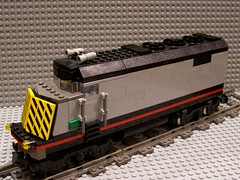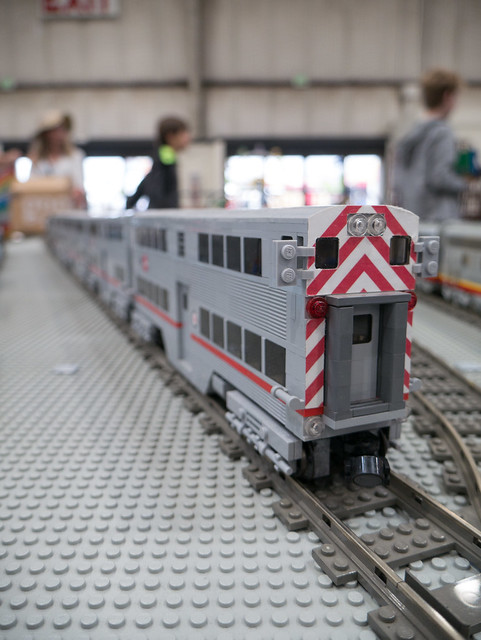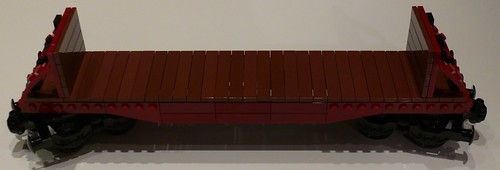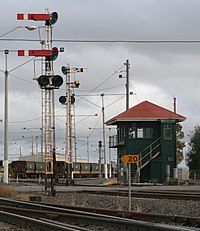This isn’t a new model, but it is one that has never been featured on my blog before, even though it was first built almost a decade ago. It’s the Gallery Car used by Caltrain commuter rail service on the San Francisco peninsula, to go with my Caltrain F40PH locomotive.
Tag: train
New page: LEGO Train Types
I’ve added a new page to the Reference section of my site, LEGO Train Types which outlines the various types of train sets LEGO has produced over the years. Did you know the first LEGO electric trains came out in 1966?
Bulkhead Flatcar
This Railroad flatcar with bulkheads was inspired by the NMRA 2011 official HO gauge car for this July’s convention in Sacramento.
Here’s a picture of the prototype I based it on:

A bunch of us are planning to put together a large LEGO layout at the NMRA convention in Sacramento this July. If you want to join the effort, check out the planning wiki and sign up to participate.
RoadRailer Trailer
This cargo trailer is both a railcar and a trailer for a truck. The rail wheelsets are removable, and the road wheels are then available to be towed down the road. I built this many years ago and it’s been on numerous BayLTC train layouts, but I never put pictures online until now.
I first learned about these interesting hybrid vehicles on the PBS television show Tracks Ahead. They are a real thing made by Wabash National. Each trailer has permanently-attached road wheels, and can have railroad wheelsets attached for use in a train. The trailers are hitched to each other, with the wheelset mounted on the rear of the trailer, and a special wheelset is attached to the front one.
See the Flickr photoset for detailed pictures from various angles, or click for a slideshow.
By the way, when I posted my Gondola car, I said that was my first train car MOC. Technically I guess the RoadRailers are, but the Gondola is more of a “train car” in the traditional sense, whereas the RoadRailers are more road trailers that can be carried as a part of a train in my mind.
Train Semaphore Signal
This has been a feature of many BayLTC train layouts over the past few years.
This is an old-fashioned train signal, or "semaphore," which uses lights for nighttime use and an arm at various angles for daytime use. Signals like these were widely used on railroads all over the world in the early days, but particularly in North America they have been phased out and replaced with light signals. Now you mostly see them on tourist railroads or in train museums. Here is an example (from the Wikipedia Railway semaphore signal article) of an Australian version of this:
Update: I make no claim of accuracy for any particular railroad. In my research online I found many different systems for semaphore signals, both “upper quadrant” (such as this model) and “lower quadrant.” Different colors and designs were used on different railroads, and across different countries. There was probably some railroad somewhere that used a signal like mine, but I couldn’t tell you which one. Here’s another article about early railroad signaling if you are interested in reading more.
Caltrain F40PH Locomotive
I keep building stuff and using it in BayLTC displays but not posting them online! Here’s another example. This locomotive was built a few years ago, not long after I first got the Super Chief, which sadly has long been discontinued. Like the Super Chief, the top lifts off and it has a control cab with prime mover motor modeled inside. I also added a head-end unit.
Here’s another example. This locomotive was built a few years ago, not long after I first got the Super Chief, which sadly has long been discontinued. Like the Super Chief, the top lifts off and it has a control cab with prime mover motor modeled inside. I also added a head-end unit.
Key features I’m particularly proud of are the cockpit windows (mounted on plate hinges) and cooling fans (made from 4×4 turntables, taken apart – the base is mounted on the top of the roof, and the top of the turntable is placed underneath to represent intakes). The nose is also mounted at a difficult angle; this is achieved by a combination of hinge elements.
The color scheme is based on the Caltrain commuter trains which run between San Francisco and San Jose, CA. The exterior detailing is minimal, and not terribly accurate (for one thing, the real thing has red and white stripes on the nose, not yellow and black), but at most of our train shows people have immediately recognized it as a Caltrain so I consider it a success.








